Print Design vs. Web Design: Decoding the Design World’s Greatest Duel

The ongoing debate of Print Design vs. Web Design has stirred insightful opinions and perspectives among industry professionals for years. At the crux of this discussion lies a comparison between the tangible, timeless allure of print and the dynamic, ever-evolving realm of web.
Some argue that the tactile sensation of flipping through a beautifully designed magazine or feeling the texture of a business card holds a certain irreplaceable magic.
Others contend that the interactive, expansive nature of web design, with its ability to reach audiences globally and adapt instantaneously, represents the future of the design industry.
Yet, despite their contrasts, both have their unique strengths and applications. As we delve deeper into the nuances of Print Design vs. Web Design, one can’t help but wonder: is it truly a matter of one over the other, or can the two coexist and even complement each other in this digital age?
Table of Contents
Historical Context: Print Design vs. Web Design
Before delving into Print Design vs. Web Design, let’s trace back to their origins. Print Design has its roots in ancient manuscripts and the Gutenberg press, providing a tangible connection.
In contrast, Web Design is born from the digital age, evolving rapidly with technological advancements.
- Print Design: A journey from ancient manuscripts to the Gutenberg press, rooted in tangible art forms.
- Web Design: A child of the digital age, evolving from static pages to dynamic platforms in mere decades.
Core Principles Outlined
When breaking down Print Design vs. Web Design, their foundational principles stand out:
Print Design:
- Tactility: The joy of feeling paper.
- Spatial Awareness: Utilizing every inch.
- Tangible Experience: The magic of holding a design.
Web Design:
- User Interaction: Clicks, scrolls, and swipes.
- Responsiveness: Adapting to multiple screen sizes.
- Dynamic Presentation: Content that moves and changes.
A Dive into Medium and Presentation
Whether it’s the tangible feel of a print brochure or the interactive allure of a website, each has its unique charm and challenges.
Design is where science and art break even.
Robin Mathew
The Color Conundrum
Colors play a distinctive role in Print Design vs. Web Design. Print primarily utilizes the CMYK spectrum, focusing on how ink translates to paper. Web Design thrives in the RGB color model, ensuring vividity on digital screens.
Print Design:
- Operates in the CMYK color spectrum.
- Focuses on ink-to-paper reproduction.
Web Design:
- Dances in the RGB realm.
- Ensures vibrancy on digital displays.
Typography Talks
As design legend Paul Rand said, “Type is a beautiful group of letters, not a group of beautiful letters.” Understanding typography is pivotal in both realms:
Print:
- Varied font choices.
- Emphasis on paper quality and print technique.
Web:
- Web-safe fonts are key.
- Browser compatibility and load speed matter.
Interactivity vs. Static Allure
A poster might capture attention with a stellar visual, while a website does it with clickable buttons and multimedia. It’s the beauty of static versus dynamic design.
Tools of the Trade
Designers in the Print Design vs. Web Design realms have their favorite design tools. Print designers often lean on Adobe InDesign and Illustrator, while web designers might turn to platforms like WordPress or tools like Figma.
Print Designers Love:
- Adobe InDesign
- Adobe Illustrator
Web Designers Swear By:
- WordPress and Wix
- Sketch and Figma
Skillsets Differ, Creativity Doesn’t
“Design is thinking made visual.” – Saul Bass
Print or web, creativity remains the essence. While the former might need a keen layout sense, the latter delves deep into coding and digital interactivity.
Future Glances
With design trend 2024 hinting at augmented reality, the lines might blur even more. Tech advances like QR codes find a home in both print and web, signaling exciting times ahead.
Making the Choice
So, in the battle of Print Design vs. Web Design, which should your brand lean into? If tangible and broad reach appeals to you, print might be the way.
If you prefer global access and dynamism, web design holds the key. Remember, expert options like an on-demand design agency can guide you. Or delve into resources to effectively hire graphic designers.
The Ultimate Design Fusion: When Print Meets Web
A stellar logo design or a compelling mascot design transcends mediums. Design, be it print or web, tells a story.
As the renowned designer, Massimo Vignelli said, “Design is not just what it looks like and feels like. Design is how it works.”
Let your brand’s narrative shine in every medium.
Looking for someone who masters both realms of design or seeking expertise tailored to your project’s specific needs? At TripleGrowth, we navigate the intricacies of both print and web design to bring your vision to life. Let’s embark on your design journey together. Reach out to us today.
What’s the main difference between Print Design and Web Design?
Print design is geared towards physical media like brochures and posters, while web design focuses on digital platforms like websites and apps.
Can a print designer work on web design projects and vice-versa?
While the fundamental principles of design apply to both, specialization in either field is recommended due to distinct technical requirements.
Which is more in-demand: Print Design or Web Design?
Web design is currently more in-demand due to the digital shift, but print design remains crucial for specific industries and marketing strategies.
Do I need separate designers for print and web projects at TripleGrowth?
At TripleGrowth, we have versatile designers proficient in both realms, ensuring cohesive branding across all mediums.
How do design trends 2024 impact Print Design vs. Web Design?
Design trends influence both areas, with web design often adopting more interactive and dynamic shifts, while print design explores innovative layouts and materials.


